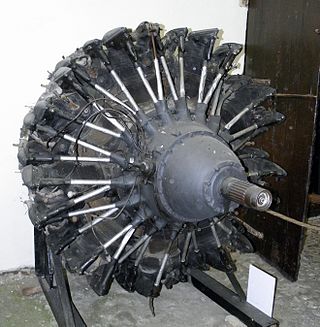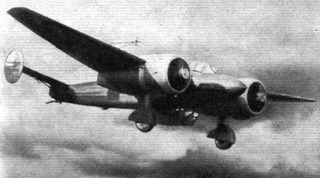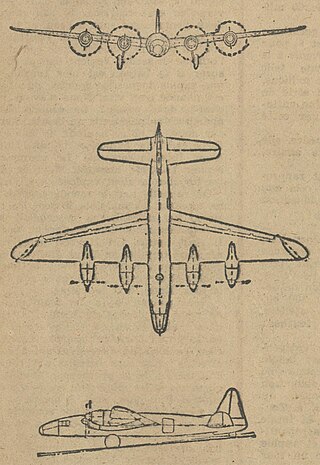
The Dornier Do 12 Libelle III was the third of a line of small German flying boats of the 1930s. It started with the Dornier A Libelle I and the Dornier A Libelle II, though the Do 12 was not a continuation, but an entirely new aircraft.

The Bloch MB.210 and MB.211 were the successors of the French Bloch MB.200 bomber developed by Société des Avions Marcel Bloch in the 1930s and differed primarily in being low wing monoplanes rather than high wing monoplanes.

The Farman F.220 and its derivatives were thick-sectioned, high-winged, four engined French monoplanes from Farman Aviation Works. Based on the push-pull configuration proven by the F.211, design started in August 1925 and the first flight of the prototype was on 26 May 1932. The largest bomber to serve in France between the two world wars was the final F.222 variant. One variation was intended to be an airliner.

The Gnome-Rhône 14M was a small 14-cylinder two-row air-cooled radial engine that was used on several French and German aircraft of World War II. While having the same appearance, number of pistons (14) and two-row layout typical of Gnome-Rhône radial engines, the 14M was built to a smaller frame intended to power a lighter class of aircraft. It was designed with lower displacement and power, smaller in size and with less weight compared to the larger, heavier Gnome-Rhône 14N and its well-known predecessor.

The Gnome-Rhône 14N was a 14-cylinder two-row air-cooled radial engine designed and manufactured by Gnome-Rhône just before the start of World War II. A development of the Gnome-Rhône 14K, the 14N was used on several French and even one German aircraft.

The Gnome-Rhône 9K Mistral was a nine-cylinder 550 hp (405 kW) to 700 hp air-cooled radial engine, that started life as an enlarged Gnome-Rhône 7K with two extra cylinders.

The Potez 62 was a French twin-engine civil airliner, designed by Henry Potez in 1934. The French military adapted this airframe two-years later to create the Potez 650.

The Farman NC.470 was a French twin-engined floatplane designed as a crew trainer for the French Navy. It was used in small numbers for both its intended role as a trainer and as a coastal reconnaissance aircraft at the start of World War II.
The Bréguet 890 Mercure was a late 1940s French cargo and passenger transport aircraft designed by Bréguet Aviation. Three variants were produced including a military variant called the Mars but none entered production.
The Bréguet 500 Colmar was a 1940s French airliner designed by Bréguet Aviation. Two prototypes were built during the Second World War but only one survived to fly in 1945. The prototype went on to operate as a VIP transport with the French Air Force but no others were built.

The SNCAC NC.150 was a prototype French high-altitude bomber aircraft designed and flown just prior to the start of the Second World War. It was a twin-engined monoplane, with a third engine driving a supercharger. Although testing was promising, and orders were planned for a modified version as a back-up for the Lioré et Olivier LeO 45 and Amiot 354 bombers, the surrender of France in June 1940 ended development with only the single example being built.

The SNCAC NC.4-10 was a twin-engine floatplane torpedo bomber built in France in the late 1930s. It was one of several prototypes competing for a Navy specification but no contracts were awarded after the military lost interest in the type.

The SNECMA 14R was a 14-cylinder two-row air-cooled radial engine developed in France just prior to the start of World War II from the Gnome-Rhône 14N. The 14N radial engine was itself an improved version of the popular pre-war Gnome-Rhône 14K Mistral Major series; designed and manufactured by Gnome et Rhône, a major French aircraft engine manufacturer whose origins pre-date the First World War.
The Bernard 160 was a three engine, multi-role monoplane designed in the early 1930s to meet a French government call for aircraft suited to policing and medical duties in its African colonies. Two prototypes were built and tested, but no further orders were placed.

The Piaggio P.XII is an Italian 18-cylinder radial aircraft engine developed in the 1930s by Rinaldo Piaggio S.p.A. The P.XII was two Piaggio P.X engines in tandem, which were versions of the French Gnome-Rhône 9K Mistral made under license, themselves being much modified Gnome-Rhône 9A - a license-built Bristol Jupiter.

The SNCAC NC-600 was a prototype French twin-engined long-range fighter aircraft, developed by SNCAC from the earlier Hanriot H.220 fighter. The type never entered service, with development being ended by the French surrender in June 1940.

The SNCAC NC.510 was a twin-engine French reconnaissance, army co-operation or advanced training aircraft, built in the late 1930s. Three were built and refined but production orders were not forthcoming.

The SNCASE SE-1010 was a late 1940s French photo-survey aircraft designed and built by SNCASE for the Institut Géographique National, one prototype was built but it crashed and the project was cancelled.

The SNCAC NC.1070 was a piston engined attack and torpedo bomber designed and built in France shortly after World War II. The second prototype, the NC1071, was the first French multi-jet turbine powered aircraft.

The SPCA 10 or SPCA Paulhan-Pillard E.5 was a large, all-metal, French reconnaissance and bomber flying boat flown in 1928. Only one was built, and it was lost in a fatal crash during development.


















